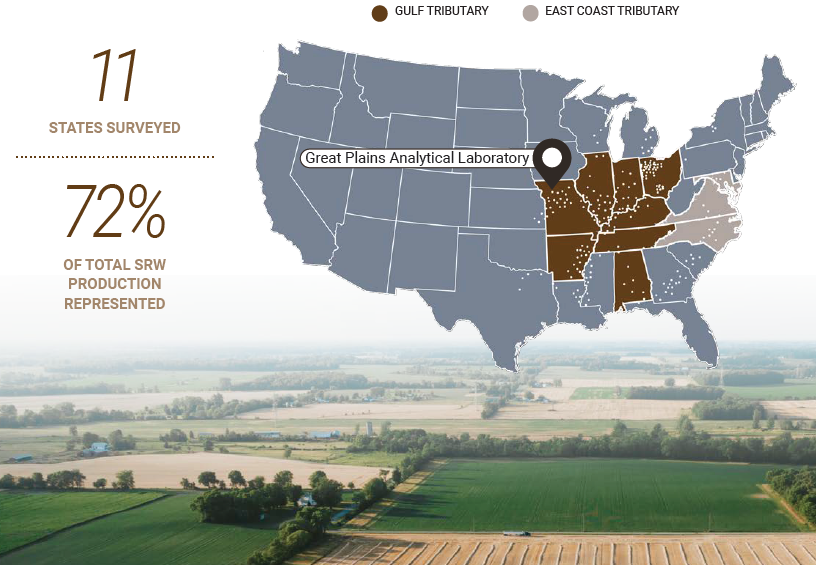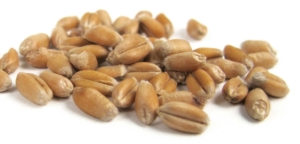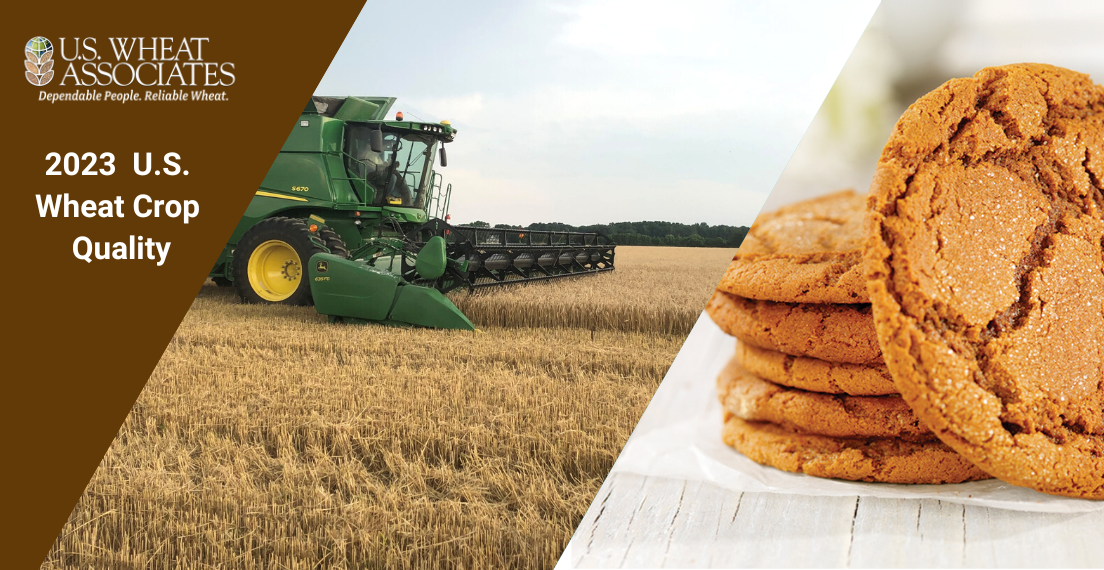Soft Red Winter Wheat Farmers Produce Another Large Crop with Excellent End-Use Quality
Attractive cash prices, a good agronomic fit, and excellent breeding and crop management have once again combined to help produce a large and high-quality U.S. soft red winter wheat crop in 2023.
Soft red winter (SRW) is grown over a wide area of the eastern United States that experienced generally good growing conditions in the 2023 crop year. This crop is very sound with high test weight and falling number values, large kernel size, good milling characteristics, and is relatively free of DON. Processors will find a versatile crop with good qualities for cookies, cakes, and crackers. With higher protein and good extensibility, the crop should also be valuable in blending for baking applications.

Great Plains Analytical Laboratory, Kansas City, Mo., collected, tested, and analyzed 232 samples from elevators in 18 reporting areas across 11 states: 46 samples were from East Coast states and 186 from Gulf states.
The full SRW Quality Survey will be available soon online here. Buyers are encouraged to review their quality specifications and work with their local U.S. Wheat Associates (USW) representatives to ensure that purchases meet their expectations.
The Season in Review
USDA estimates the total SRW seeded area for 2023 harvest at 3.10 million hectares, up 12% seeded for the 2022 harvest and up 26% over the 5-year average, making this the most planted area since 2014.
Early development was good and much of the soft red winter growing area received plentiful moisture through the winter and spring with only Maryland seeing a decrease in soil moisture. Later in the season, mild temperatures and rainfall benefited critical kernel development.
Harvest began in mid-May and picked up pace in early-June with unusually dry conditions and below-average temperatures. Weather patterns changed by mid-June with widespread rain causing harvest delays in North Carolina, Maryland, and Ohio.
However, USDA estimates the 2023 SRW crop to be 12.0 MMT, up from both 9.2 MMT in 2022 and the 5-year average of 8.1 MMT, making this the largest SRW production in 9 years and highest yield on record.
2023 Crop Highlights
- The overall average sample grade for the 2023 soft red winter harvest survey is U.S. No. 1 SRW; the Gulf average is U.S. No. 1 SRW, and East Coast is U.S. No. 2.
- Test weight averages trended higher and indicate a sound crop with Composite average 60.3 lb/bu (79.3 kg/hl), Gulf average 60.4 lb/bu (79.5 kg/hl) and East Coast 59.6 lb/bu (78.4 kg/hl).
- The wheat falling number overall average of 320 seconds is below 2022 but above the 5-year average and indicates there is very little sprout damage in the crop; lower East Coast average is due to rainfall at harvest.
- Single kernel values reflect a consistent crop. Kernels are harder, heavier, and larger than last year’s and 5-year averages.
- Vomitoxin (DON) averages are well below the USDA threshold of 2.0 ppm and indicate the sampled crop is relatively free of DON.
- Amylograph data indicate suitable starch characteristics for batter-based products. The 2023 averages for Composite (655 BU) and Gulf (709 BU) are very sound, reinforce the high falling numbers, and indicate very low levels of amylase activity. The East Coast value of 401 BU reflects this year’s slightly lower falling number values.
- Solvent Retention Capacity (SRC) values indicate excellent quality for all typical applications. Sucrose values indicate cookies and crackers will benefit from reduced bake time and should not experience any excess water-holding issues.
- Dough properties suggest this crop is typical for SRW although weaker than the 5-year average
- Alveograph data indicate a crop that is less extensible, more resistant/tenacious than last year and is suitable for blending applications: P values: Composite (51 mm), East Coast (50 mm) and Gulf (52 mm); L values: Composite (57 mm), East Coast (56 mm) and Gulf (57 mm).
- Cookie diameter values are consistent across the soft red winter crop (9.0 cm) and are higher than last year but similar to the 5-year average, indicating this crop has adequate to good spreadability.
- Loaf volume averages are lower than last year and 5-year averages, which is consistent with alveograph data, and indicate this crop is suitable for blending: Composite (602 cc), East Coast (587 cc) and Gulf (606 cc).
By USW Vice President of Programs Erica Oakley


